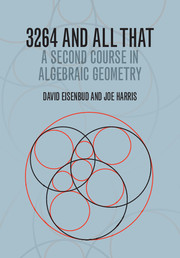Book contents
- Frontmatter
- Contents
- Preface
- Chapter 0 Introduction
- Chapter 1 Introducing the Chow ring
- Chapter 2 First examples
- Chapter 3 Introduction to Grassmannians and lines in ℙ3
- Chapter 4 Grassmannians in general
- Chapter 5 Chern classes
- Chapter 6 Lines on hypersurfaces
- Chapter 7 Singular elements of linear series
- Chapter 8 Compactifying parameter spaces
- Chapter 9 Projective bundles and their Chow rings
- Chapter 10 Segre classes and varieties of linear spaces
- Chapter 11 Contact problems
- Chapter 12 Porteous' formula
- Chapter 13 Excess intersections and the Chow ring of a blow-up
- Chapter 14 The Grothendieck Riemann–Roch theorem
- Appendix A The moving lemma
- Appendix B Direct images, cohomology and base change
- Appendix C Topology of algebraic varieties
- Appendix D Maps from curves to projective space
- References
- Index
Chapter 1 - Introducing the Chow ring
Published online by Cambridge University Press: 05 March 2016
- Frontmatter
- Contents
- Preface
- Chapter 0 Introduction
- Chapter 1 Introducing the Chow ring
- Chapter 2 First examples
- Chapter 3 Introduction to Grassmannians and lines in ℙ3
- Chapter 4 Grassmannians in general
- Chapter 5 Chern classes
- Chapter 6 Lines on hypersurfaces
- Chapter 7 Singular elements of linear series
- Chapter 8 Compactifying parameter spaces
- Chapter 9 Projective bundles and their Chow rings
- Chapter 10 Segre classes and varieties of linear spaces
- Chapter 11 Contact problems
- Chapter 12 Porteous' formula
- Chapter 13 Excess intersections and the Chow ring of a blow-up
- Chapter 14 The Grothendieck Riemann–Roch theorem
- Appendix A The moving lemma
- Appendix B Direct images, cohomology and base change
- Appendix C Topology of algebraic varieties
- Appendix D Maps from curves to projective space
- References
- Index
Summary
Keynote Questions
As we indicated in the introduction, we will preface each chapter of this book with a series of “keynote questions:” examples of the sort of concrete problems that can be solved using the ideas and techniques introduced in that chapter. In general, the answers to these questions will be found in the same chapter. In the present case, we will not develop our roster of examples sufficiently to answer the keynote questions below until the second chapter; we include them here so that the reader can have some idea of “what the subject is good for” in advance.
(1) Let F0, F1 and F2 ∈ k[X, Y, Z] be three general homogeneous cubic polynomials in three variables. Up to scalars, how many linear combinations t0F0+t1F1+t2F2 factor as a product of a linear and a quadratic polynomial? (Answer on page 65.)
(2) Let F0, F1, F2 and F3 ∈ k[X, Y, Z] be four general homogeneous cubic polynomials in three variables. How many linear combinations t0F0 + t1F1 + t2F2 + t3F3 factor as a product of three linear polynomials? (Answer on page 65.)
(3) If A, B, C are general homogeneous quadratic polynomials in three variables, for how many triples t = (t0, t1, t2) do we have
(A(t), B(t), C(t)) =. t0, t1, t2?
(Answer on page 55.)
(4) Let S ⊂ ℙ3 be a smooth cubic surface and L ⊂ ℙ3 a general line. How many planes containing L are tangent to S? (Answer on page 50.)
(5) Let L ⊂ ℙ3 be a line, and let S and T ⊂ ℙ3 be surfaces of degrees s and t containing L. Suppose that the intersection S ⋂ T is the union of L and a smooth curve C. What are the degree and genus of C? (Answer on page 71.)
The goal of intersection theory
Though intersection theory has many and surprising applications, in its most basic form it gives information about the intersection of two subvarieties of a given variety. An early incarnation, and in some sense the model for all of intersection theory, is the theorem of Bézout: If plane curves A, B ⊂ ℙ2 intersect transversely, then they intersect in (deg A)(deg B) points (see Figure 1.3 on page 18).
- Type
- Chapter
- Information
- 3264 and All ThatA Second Course in Algebraic Geometry, pp. 13 - 42Publisher: Cambridge University PressPrint publication year: 2016

